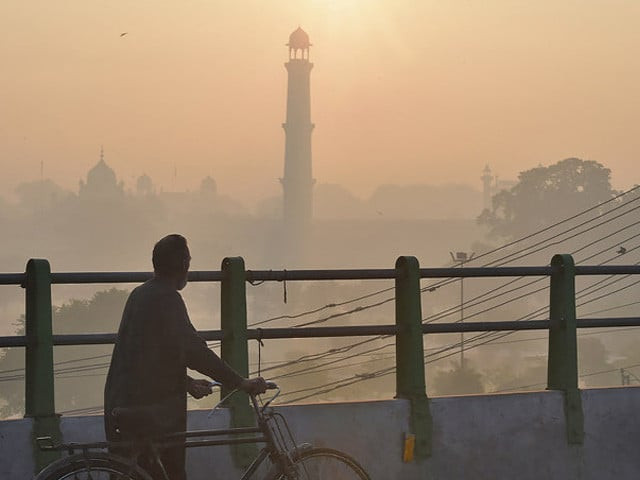Smog: Facing unsustainable management again
Six years down and there is still no viable, visible, and sustainable management of air quality in Punjab

Once again, the government of Punjab is actively working to control smog and has mobilised the relevant departments and resources as a snap-shot intervention. We face smog every year, but the concerned departments are working reactively rather than tackling this persistent issue proactively. Every year, as winter approaches and signs of smog appear, we start our preparations and create an emergency situation for the public, as well as private sector stakeholders. Citizens suffer in between, and no long-term sustainable plan is visible as it is treated as a seasonal activity. All institutional arrangements (EPAs) and the legal framework to control smog are in place, but they become active when the required dry and cold conditions arrive, without any air current to allow the suspension of airborne particulate matter in the air, turning it into dark days with no visibility and paralysing life.
Air quality in major cities of Pakistan does not conform to the ambient air quality standards specified in the National Environment Quality Standards (NEQS) and provisions of the Pakistan Environment Protection Act 1997. Recent reports, like the Air Quality Index (AQI), show that Lahore, with a 158 AQI, is an unhealthy city, and Islamabad, with a 149 AQI, is unhealthy for sensitive people. The major causes of poor air quality are industrial emissions, vehicular emissions, domestic emissions, dust emissions from construction, smoke from brick kilns, and soot from burning agricultural waste. Polluted air, being denser, provides a platform for smog formation in winter months, causing heavy economic losses by disrupting communication, in addition to health issues and accidents. The World Air Quality Report for 2018 showed that Lahore ranked 10 in IQAir’s AirVisual sensor, Faisalabad ranked at number 3, Islamabad’s air pollution was at number 239, and Karachi stood at number 318.
Read Rains bring smog relief for trade, education
In a public interest petition heard by the Lahore High Court in 2017, the court ordered the concerned authorities to prepare an updated smog response action plan and publish daily pollution updates until hourly updates could be published, as non-government monitoring agencies do. Following the court order, the Punjab Environment Protection Council approved a Smog Action Plan and adopted an Air Quality Index (AQI) classification system in 2017. However, the AQI has been criticised by air quality advocates for being too lax and underreporting the severity of the prevailing air pollution. The US AQI deems a PM-Particulate Matter 2.5 concentration of 60 micrograms per cubic meter in the air as “Unhealthy,” whereas Punjab’s AQI reads it as “Satisfactory,” with the advice: “May cause minor breathing discomfort for sensitive people.” Smog continues to cripple life in Lahore and other cities, but almost six years down the line, there is no viable, visible, and sustainable management of air quality and smog in Punjab. Identifying where and why the system is failing is essential for correction.
Smog is the direct result of industrialisation and increased use of fossil fuels in road transportation. This was also a global problem, and countries like the USA, Europe, and Japan faced heavy smog in the early fifties and sixties due to increased industrialisation and transportation. They effectively controlled smog by developing air quality monitoring systems, air quality standards, and regulations. They implemented these laws, strictly monitored ambient air quality, and analysed it through reporting systems, which are now online. This allowed them to maintain air quality at the desired level and significantly reduce smog. Pakistan is now facing a situation similar to what advanced countries faced in the fifties and sixties, and we must learn from their successful case studies to effectively control smog in Pakistan.
Pakistan is a member of various UN Environment forums and has access to technology and resources for maintaining clean air in major cities. Global and regional initiatives like the Asia and Pacific Regional Clean Air Initiatives and the Mali Declaration on monitoring trans-boundary air quality in South Asia provide the necessary tools and techniques for effectively controlling smog in Pakistan. Monitoring trans-boundary air quality in South Asia was established in the late nineties, with well-equipped air quality monitoring stations at the borders of member countries. However, this system has been disrupted due to inactivity since its fourth phase ended in 2012-13. Reactivating the trans-boundary air quality monitoring system in South Asia is crucial.
Environmental regulations are enforced by federal and provincial Environment Protection Agencies (EPAs), but the capacity and enforcement mechanism is weak and insufficient. Provincial EPAs are responsible for monitoring air quality, but poor capacity, a lack of efficient air quality monitoring equipment, and insufficient support from mainstream policing authorities hamper the enforcement of air quality regulations. Weak environmental tribunals and ineffective handling of air pollution cases contribute to the problem. Most environmental tribunals are ineffective or non-functional due to a lack of the required quorums or chairpersons. Delays in the disposal of environmental complaints have favoured an increase in poor air quality in urban centres. Weak verdicts and small punishments for environmental crimes have encouraged violators to continue polluting.
Way forward
Air quality monitoring is a cross-cutting issue involving various stakeholders, and innovative approaches are needed for a sustainable solution. The following recommendations may help policymakers, planners, and implementing agencies formulate appropriate and sustainable air quality strategies:
Read more ‘Vehicle fitness checks mandatory to control smog’
1. Make real-time air quality data available to the public to enable informed decisions and actions to protect against air pollution.
2. Identify and list all stakeholders, including both polluters and regulators at all levels.
3. Create awareness through community mobilisation initiatives.
4. Develop an incentivised community involvement program to divide work among the available population in affected geographical areas.
5. Build the capacity of stakeholders based on their roles and levels of involvement in air pollution control and monitoring.
6. Revise rules to empower communities and facilitate open-ended
enforcement.
7. Identify economically viable and socially acceptable alternatives to pollution sources such as transportation, industry, construction, waste burning, etc.
8. Develop and implement strategies with measurable and achievable objectives and outputs.
9. Improve the capacity and enforcement powers of the air quality monitoring and control system, ensuring consistent and continuous clean air provision to citizens.
THE writer HOLDS A PHD IN NATURAL RESOURCES MANAGEMENT AND HAS WORKED IN NATIONAL AND REGIONAL AIR QUALITY REGULATING AND MONITORING AGENCIES
Published in The Express Tribune, October 30th, 2023.
Like Business on Facebook, follow @TribuneBiz on Twitter to stay informed and join in the conversation.



















COMMENTS
Comments are moderated and generally will be posted if they are on-topic and not abusive.
For more information, please see our Comments FAQ